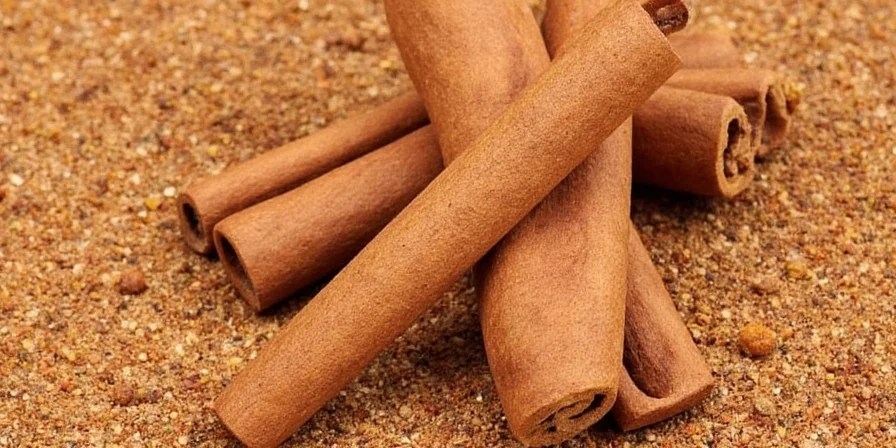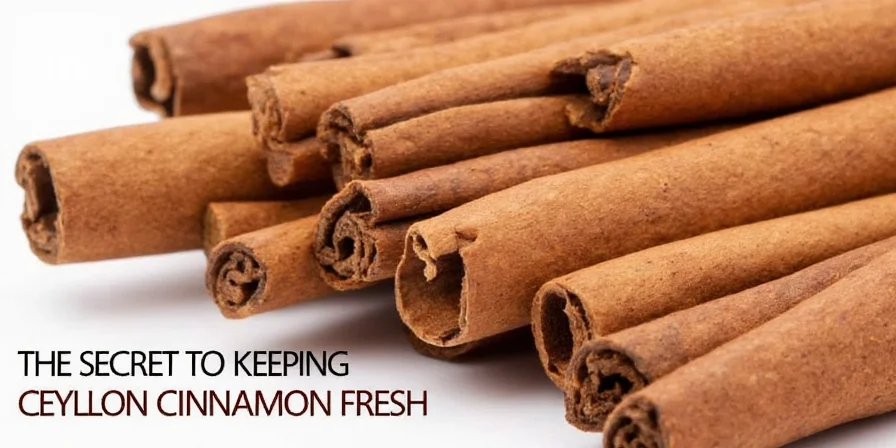Unlock the Full Flavor of Ceylon Cinnamon with These Pro Tips

Why Ceylon Cinnamon Stands Out in the Spice World
Ceylon cinnamon, also known as 'true cinnamon,' is a prized spice that originates from Sri Lanka. Unlike its cousin, cassia cinnamon (which is more commonly found in supermarkets), Ceylon cinnamon boasts a more delicate and complex flavor profile. It's often described as sweet, floral, and slightly woody, making it a favorite among chefs and home cooks alike. However, this delicate nature also means that it requires special care when it comes to storage and usage.
If you're lucky enough to have access to real Ceylon cinnamon, you want to make sure that it stays as fresh as the day you bought it. In this blog post, we’ll walk you through the best ways to store and use Ceylon cinnamon, so that you can unlock its full potential in your cooking.
The Science of Spice Degradation: What Happens to Ceylon Cinnamon Over Time
Spices, including Ceylon cinnamon, are living things in a way. They contain volatile compounds that give them their aroma and flavor. Over time, these compounds can evaporate, especially when exposed to heat, light, and moisture. This is why properly storing your spices is so important.
Ceylon cinnamon, in particular, is highly sensitive to moisture. If it gets damp, it can become clumpy and lose its potency. It’s also sensitive to heat. Storing it near the stove or in a sunny kitchen cabinet can cause it to lose its aromatic qualities.
Here's a quick breakdown of what happens to Ceylon cinnamon over time:
| Condition | Effect on Ceylon Cinnamon |
|---|---|
| Exposure to heat | Loss of volatile oils, leading to a duller flavor |
| Exposure to light | Breakdown of essential oils, resulting in a less intense aroma |
| Exposure to moisture | Clumping and mold growth |
| Proper storage | Prolonged freshness and potency |
Pro Tips for Storing Ceylon Cinnamon
Now that we’ve covered what can go wrong, let’s dive into the best practices for storing your Ceylon cinnamon. Here are some expert-level tips that will help you keep your spice in top condition:
1. Store in an Airtight Container
The first and most important rule of spice storage is to keep it in an airtight container. This will help prevent the loss of essential oils and protect the spice from moisture and light.
Look for glass jars with tight-fitting lids. These are ideal for storing Ceylon cinnamon. Avoid using plastic containers, as they can sometimes absorb the oils from the spice and leave a lingering flavor in the container.
2. Keep It Cool and Dark
Heat and light are the number one enemies of your spices. That’s why you should store your Ceylon cinnamon in a cool, dark place—like a pantry or a cabinet away from the stove and windows.
Avoid storing it in the refrigerator or freezer. While it might seem like a good idea to keep it cold, moisture in the fridge can cause it to clump and lose its potency. Plus, the humidity in the fridge can be a breeding ground for bacteria and mold.
3. Grind It Fresh for Maximum Flavor
If you're using Ceylon cinnamon in your cooking, it's best to grind it fresh. Pre-ground cinnamon can lose its potency quickly and often contains fillers or other additives.
Invest in a good quality spice grinder that can handle small quantities without overheating. A mortar and pestle also work well for grinding small amounts of cinnamon. Just make sure to clean it thoroughly after each use to avoid cross-contamination.
4. Use It in the Right Dishes
Ceylon cinnamon is a versatile spice that can be used in both sweet and savory dishes. However, it's best used in dishes that don't involve high heat for long periods of time, as this can cause the spice to lose its flavor.
Some of the best dishes to use Ceylon cinnamon in include:
- Spiced chai or coffee
- Baked goods like cinnamon rolls or cookies
- Curries and stews (especially in Sri Lankan and Indian dishes)
- Yogurt or fruit compote
When using it in savory dishes, be careful with the amount. A little goes a long way. Too much can make the dish taste bitter or overpowering.
5. Label and Date Your Spices
It’s easy to forget when you bought your spices, especially if you have a large collection. To keep track of how fresh your Ceylon cinnamon is, label each container with the date you stored it.
This will help you know when it's time to replace it. As a general rule, whole Ceylon cinnamon can last up to 2 years if stored properly, while ground cinnamon should be used within 6 months for optimal flavor.
Common Mistakes to Avoid When Storing Ceylon Cinnamon
Even the most well-meaning cooks can make mistakes when it comes to spice storage. Here are a few common pitfalls to watch out for:
- Storing it in the fridge or freezer: As mentioned earlier, this can lead to clumping and loss of flavor.
- Using plastic containers: These can absorb the oils from the spice and leave a lingering flavor in the container.
- Exposing it to light: Light can break down the essential oils in the spice, making it less aromatic.
- Using it in high-heat cooking: Ceylon cinnamon is best used in low-heat applications or as a finishing spice.
By avoiding these mistakes, you can ensure that your Ceylon cinnamon stays fresh and flavorful for as long as possible.
The Best Ways to Use Ceylon Cinnamon in Your Cooking
Now that we've covered how to store your Ceylon cinnamon, let's talk about how to use it. This spice is incredibly versatile and can elevate a wide range of dishes.
1. Add It to Baked Goods
Ceylon cinnamon is a staple in many baked goods, from cinnamon rolls to cookies. It adds a warm, sweet flavor that complements the other ingredients perfectly.
When using it in baked goods, be sure to grind it fresh for maximum flavor. You can also use it as a topping or a filling in pastries and cakes.
2. Use It in Spiced Drinks
Ceylon cinnamon is a key ingredient in many spiced drinks, including chai, mulled wine, and hot cocoa. It adds a warm, spicy note that pairs well with the other flavors in the drink.
To make a simple spiced chai, simply add a few cinnamon sticks to your pot of boiling water and let it steep for a few minutes. You can also add other spices like cardamom, cloves, and ginger for extra flavor.
3. Add It to Savory Dishes
While Ceylon cinnamon is often associated with sweet dishes, it can also be used in savory cooking. In Sri Lankan and Indian cuisine, it's a common ingredient in curries, stews, and rice dishes.
It adds a subtle warmth that complements the other spices in the dish. However, as with any spice, it's best to use it in moderation to avoid overpowering the other flavors.
4. Use It as a Finishing Spice
Ceylon cinnamon is best used as a finishing spice, especially in dishes that are served at room temperature or slightly warm. This helps preserve its delicate flavor and aroma.
You can sprinkle a little cinnamon on top of yogurt, fruit compote, or even roasted vegetables. It adds a nice touch of warmth and flavor without overwhelming the dish.
Final Thoughts: Keep Your Ceylon Cinnamon Fresh and Flavorful
With a little care and attention, you can keep your Ceylon cinnamon fresh and flavorful for months, if not years. By following the tips outlined in this blog post, you’ll be able to enjoy the full range of flavors that this spice has to offer.
Remember, Ceylon cinnamon is a delicate spice that requires special care. Store it in an airtight container, keep it cool and dark, and use it in the right dishes. With the right storage and usage techniques, your Ceylon cinnamon will remain a staple in your kitchen for years to come.
Ready to Elevate Your Cooking with Ceylon Cinnamon?
Now that you know the best ways to store and use Ceylon cinnamon, you're ready to take your cooking to the next level. Whether you're making a spiced chai, a cinnamon roll, or a savory curry, this spice is sure to add a touch of warmth and flavor to your dishes.
So go ahead—grab your jar of Ceylon cinnamon, and start experimenting in the kitchen. Your taste buds will thank you.

Explore More Spice Storage Hacks
If you're interested in learning more about spice storage and usage, be sure to check out our other blog posts on the topic. We have a wealth of information on how to keep your spices fresh, how to use them in your cooking, and much more.
Stay tuned for more tips and tricks from the world of spices. Until next time, happy cooking!










 浙公网安备
33010002000092号
浙公网安备
33010002000092号 浙B2-20120091-4
浙B2-20120091-4